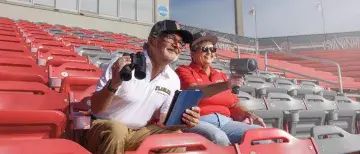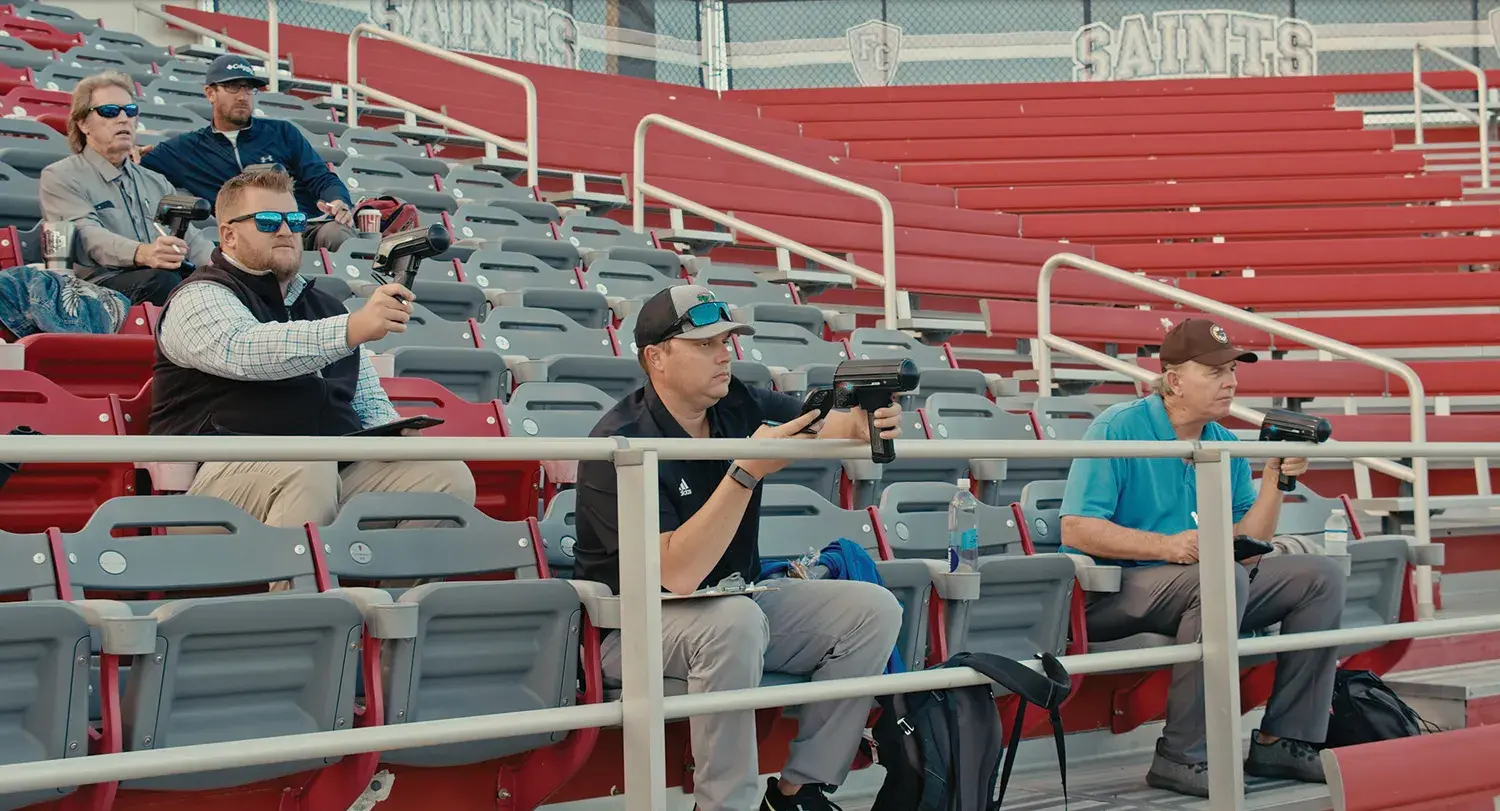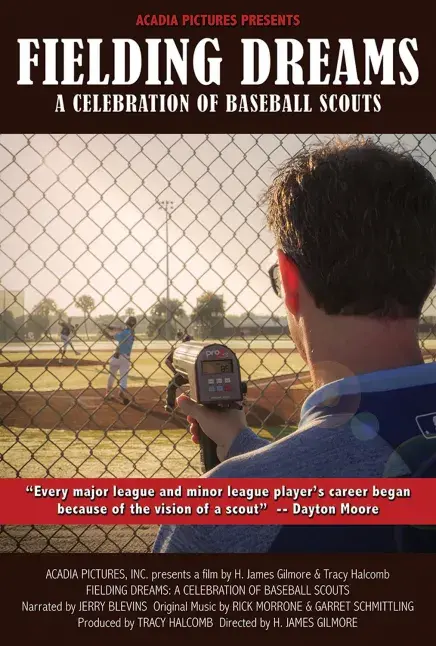
“We would get together at cocktail time or watch the sunset over Lake Michigan and talk,” said Gilmore, a Visiting Filmmaker at Flagler College. “(He) always tells stories about his life as a baseball scout. I was sort of listening and listening and finally like, ‘You know, Brian, if you keep telling these stories, I'm going to really need to turn this into some kind of a movie because this all sounds good, and it should be recorded.’”
And that is exactly what Gilmore and fellow Communication Professor Tracy Halcomb decided to do for their new documentary on these unsung heroes of American baseball.
The film, “Fielding Dreams: A Celebration of Baseball Scouts,” has dozens of interviews of scouting legends, including five scouts who helped build the 2023 World Series Champion Texas Rangers.
Since its release, “Fielding Dreams” has garnered media attention around the country, had its world premiere at the Sarasota Film Festival and even been shown at the National Baseball Hall of Fame in Cooperstown, where Gilmore and Halcomb were invited for a Q&A after the screening.

The film has generated a lot of interest in scouts, who are often overlooked for their work, even though they are so integral to making the sport happen. Without being away from their families for extended periods of time and driving hours to watch a young player for a short 20 minutes, World Series teams would not be what they are.
“Baseball scouts are the only people that are not in the Hall of Fame,” Gilmore said. “You've got players, you've got managers, you've got announcers that are in the Hall, but not baseball scouts. I think our number one hope is that this raises a little bit more awareness about what they bring to the game of baseball.”
Halcomb said the film tells a story that is deeper than just baseball – one that is really a human-interest story highlighting the life of these critical individuals and the challenges that the MLB faces. “Even though this is a baseball story, I look at it as really kind of a very heartwarming human (film),” Halcomb said.
With technology advancements, cost efficiency and post-COVID scouting cuts, the profession has been under more pressure than ever. But in spite of new challenges, what they found were scouts whose love for the sport and desire to see it continue to progress was the reason they continue to invest so much into it.
“They're passionate about this job. They love this job. They can't imagine doing anything else, even though it takes them away from their family like up to 200 nights of the year,” Halcomb said. “They still want to see this high school kid in a small town and they're gonna’ drive four hours there, pay for their own gas, watch this kid play and then drive home that night.”
The ins and outs are rarely highlighted due to little or no coverage of the endless amount of work that they do to help put together a team’s roster.
“They make the game of baseball happen,” Gilmore said. “Nothing you see happen in front of you in the ballpark would happen without an area scout identifying talent from a young man, probably when they were in their teens, and following them forward to securing them to end up becoming part of Major League Baseball. And so, I think our hope is that it raises awareness for scouts.”

Although the documentary aimed to highlight baseball scouts' work, it also presented some of the challenges that Major League Baseball faces that are often swept under the rug.
Baseball has provided endless opportunities for athletes worldwide, and many players come to the U.S. for the opportunity to play at the professional level. But players from diverse backgrounds, and especially the rate of black players and players of color, is significantly lower. Making sure to not gloss over these challenges was important to Gilmore and Halcomb.
“The dearth of African Americans in baseball, and how come there's not a lot of black baseball players, we addressed (in the film),” Halcomb said. “The fact that the statistics is it’s something like 18% of Major League players on the opening day rosters were black, and we're down to under 10 percent now.” Access to safe outdoor playing fields and facilities in black communities has been a challenge for decades. To promote change, the sport is making strides with programs and initiatives for young black athletes to have the opportunity to learn the game and have equal opportunity to pursue a career.
“Scouts have scout teams where they go into the inner cities, and different teams are now building baseball academies in some of the parts of bigger cities that just don't have the availability,” Halcomb said. “Baseball teams are starting to pay attention. So, we're hoping that it's moving the needle in the right direction.”
The life of a scout is not ordinary. Their life is spent on the road searching for the next big player for the MLB, which is something that other technological advancements can’t replace.
While scouting, they are running numbers on each player, but also going deeper than the analytics. The scouts talk with opposing teams, as well as family members, to better understand what they call the “makeup” of each player. For them, it is more than just the physical aspect of each player.
“It is way more than just having a speed gun on a pitcher and watching a guy hit a home run,” Halcomb said. “It's fascinating. It's like a science getting all the different pieces together.”
The interesting part about scouting is that the focus is not just on the athlete, and scouts get to personally know the families of each player and spend a great amount of time with them.
“I think what kind of surprised me is how much the scouts really do,” she said. “They get to know the parents, they get to know the family situation, and they take that all into account. When they talk about ‘makeup,’ … they are part psychologists.”
It’s all done in hopes of finding a player who can end up becoming a star.
“They're looking at what kind of mental toughness that they have and how much drive,” Halcomb said. “Like one scout says, you're looking at a 17-year-old trying to figure out if he's gonna’ be any good when he's 23 or 24. You're projecting five to seven years out, and so, you're taking a huge risk.” Another issue that the film brings up is the low rate of female scouts, which dates to the early 1900s.
“We interviewed a wonderful female scout named Christy Wood who works for Major League Baseball,” Halcomb said about the first female scout, who has held an on-field position with the MLB Scouting Bureau. “She goes out to all the teams and she is one of the very few female scouts.”
Gilmore said this film meant a lot to the scouts. They felt like they were seen and heard on a realistic level, unlike films that have been made about them in the past.
“So, I mean this is a much more of a realistic look at what they do every day and how they how they put those World Series teams together,” Gilmore said. Halcomb and Gilmore already work closely together in the Communication Department at Flagler, where they helped launch the new Cinematic Arts major. The program will let aspiring filmmakers get involved with all aspects of narrative and feature filmmaking in a major designed to model a real professional environment.
They recently began their first project on Fort Mose Historic State Park, site of the first legally-sanctioned free African settlement. Students will be involved in all parts of the pre-production and production stages of the film.
The two have also worked on previous projects together, including the documentary “Cracking Aces,” which focused on professional women poker players.



